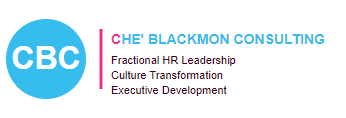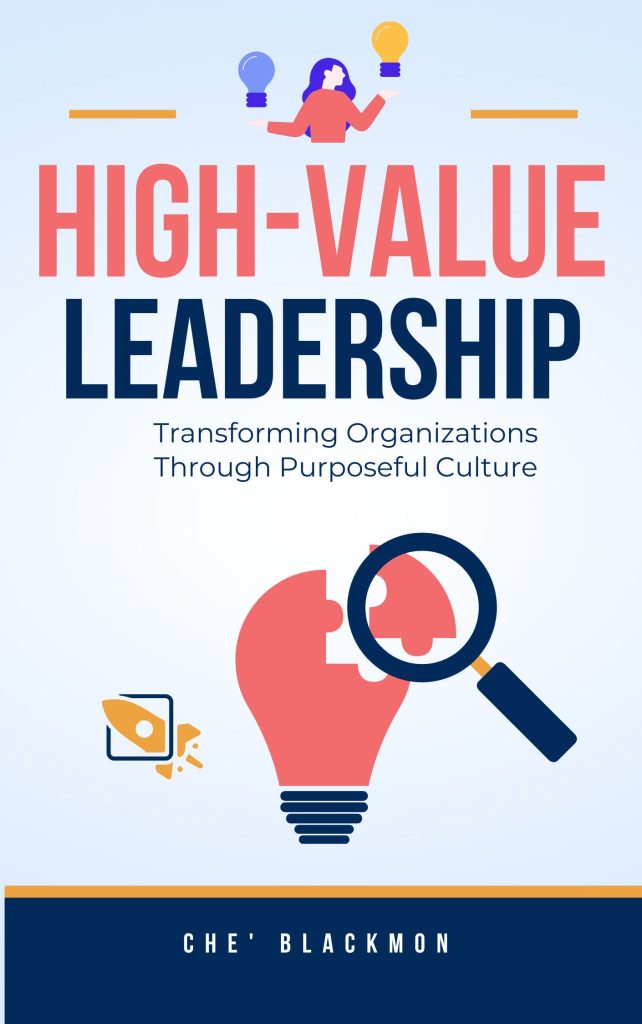Your cart is currently empty!
Beyond Intuition to Evidence-Based Leadership
“What gets measured gets managed” remains one of the most powerful principles in business. Yet when it comes to leadership effectiveness, many organizations rely on gut feelings and anecdotal evidence rather than robust measurement. At Che’ Blackmon Consulting, we believe that truly transformative leadership isn’t just felt—it’s measured, analyzed, and continuously improved through strategic performance indicators.
As I discuss in “Mastering a High-Value Company Culture,” organizations that excel at measuring leadership impact don’t just evaluate what leaders do—they measure the tangible differences leaders make. They create accountability systems that connect leadership behaviors to business outcomes, employee experiences, and cultural transformation.
The Business Case for Measuring Leadership Impact
The importance of measuring leadership effectiveness extends far beyond satisfying curiosity. Consider these compelling realities:
- Organizations with robust leadership metrics outperform their peers by 1.5 times in revenue growth and profitability
- 78% of HR leaders report that leadership measurement is inadequate in their organizations
- Only 14% of organizations effectively connect leadership behaviors to business outcomes
- Companies that measure leadership impact see 23% higher employee engagement and 31% lower turnover
- Organizations with evidence-based leadership practices are 36% more likely to respond effectively to market disruptions
A financial services organization we worked with discovered that their leadership effectiveness varied dramatically across divisions, directly affecting customer retention and employee engagement—to the tune of $8.2 million in annual impact. This finding transformed leadership development from a “nice-to-have” program to a strategic imperative with tangible ROI. These realities underscore why measuring leadership isn’t an administrative exercise, it’s a business essential with profound financial implications.
The Leadership Measurement Framework
Effective leadership measurement requires looking beyond simple metrics to develop a comprehensive framework. Based on our experience with organizations across industries and supported by leadership research, we’ve developed a five-dimensional approach that provides a complete picture of leadership impact:
1. Business Performance Metrics
The most straightforward dimension connects leadership to tangible business outcomes. A manufacturing client implemented a structured approach that linked leadership behaviors to specific operational metrics:
- Productivity increases or decreases within leader’s span of control
- Quality metrics and error rates compared to organizational benchmarks
- Customer satisfaction scores for the leader’s area of responsibility
- Revenue or profit contribution trends over time
- Project completion rates and milestone achievement
They discovered that leaders who scored highest on inclusive leadership behaviors achieved 22% higher productivity improvements and 18% better quality metrics than their peers. This finding directly connected their leadership development investments to bottom-line results, embodying our principle of measuring success through tangible transformation.
When implementing business performance measures, consider these best practices:
- Identify metrics that leaders can meaningfully influence
- Establish appropriate comparison points (historical trends, peer comparisons, etc.)
- Account for contextual factors that might affect performance
- Look for patterns across multiple metrics rather than focusing on single indicators
- Connect measurement to development rather than just evaluation
2. Talent Development Indicators
Great leaders build other leaders. This dimension measures a leader’s effectiveness in developing talent and building organizational capability. A healthcare organization we partnered with implemented these metrics:
- Internal promotion rates from the leader’s team
- Skill development progress among team members
- Performance improvement of previously struggling employees
- Diversity of the talent pipeline being developed
- Knowledge transfer effectiveness
- Bench strength improvement over time
They found that leaders who excelled in talent development contributed 3.4 times more future leaders to the organization than their peers. Moreover, these leaders retained key talent at significantly higher rates during a competitive labor market, saving substantial recruitment and onboarding costs.
This approach aligns perfectly with our core value of empowerment, building confidence and capability in overlooked talent. It recognizes that a leader’s true legacy isn’t just what they accomplish directly but the capacity they build in others.
3. Employee Experience Metrics
Leaders profoundly shape the day-to-day experience of their team members, which directly impacts engagement, performance, and retention. A technology company implemented these employee experience metrics:
- Engagement scores compared to organizational benchmarks
- Psychological safety assessments
- Retention rates, particularly for high performers
- Absenteeism and discretionary effort indicators
- Employee Net Promoter Scores
- Wellbeing and burnout measures
Through careful analysis, they identified that leaders who consistently demonstrated authentic leadership behaviors achieved engagement scores 26 points higher than those who didn’t. This difference translated directly to customer satisfaction and innovation output, creating a clear through-line from leadership behaviors to business results.
When measuring employee experience, consider these implementation guidelines:
- Use both quantitative and qualitative measures
- Ensure anonymity to encourage honest feedback
- Measure frequently enough to track trends but not so often that it creates survey fatigue
- Include forward-looking indicators (like intention to stay) along with backward-looking metrics
- Connect findings directly to leadership development plans
4. Cultural Impact Assessment
Leaders are culture carriers who significantly influence organizational values, norms, and behaviors. This dimension measures how effectively leaders shape culture in alignment with strategic priorities. A retail organization developed these cultural impact metrics:
- Values alignment scores from multi-rater feedback
- Cultural assessment results compared to organizational targets
- Innovation metrics (idea generation, implementation rates)
- Collaboration indicators across team boundaries
- Decision-making effectiveness and alignment with stated values
- Change adoption rates for strategic initiatives
They discovered that leaders who scored highest on cultural leadership achieved 41% faster implementation of strategic changes and significantly higher cross-functional collaboration. These findings helped them identify and develop leadership behaviors that would accelerate their digital transformation initiative.
This approach embodies our commitment to creating inclusive cultures that celebrate diverse perspectives and deliver high-impact solutions. It recognizes that leaders must be measured not just on what they achieve but on how they achieve it.
5. Leadership Behavior Indicators
While outcomes are critical, measuring specific leadership behaviors provides essential diagnostic information and development guidance. A professional services firm implemented these behavioral metrics:
- Structured multi-rater feedback on key leadership competencies
- Behavioral observation assessments during high-stakes situations
- Pattern analysis of leadership communications
- Decision-making process evaluations
- Time allocation analysis
- Meeting effectiveness assessments
This behavioral data helped them identify that their most effective leaders spent 2.4 times more time on strategic thinking and talent development than their less effective peers, who were consumed by operational firefighting. This insight transformed their approach to leadership development and time management coaching.
When implementing behavioral measurement, consider these best practices:
- Focus on observable behaviors rather than personality traits
- Connect behaviors to your organization’s leadership competency model
- Use multiple sources to reduce individual bias
- Provide specific behavioral examples rather than general impressions
- Create clear development paths for behavioral improvement

Case Study: Transformation Through Measurement
A mid-sized healthcare organization approached us with concerns regarding trends in patient satisfaction, staff turnover, and financial performance. Their leadership development efforts weren’t yielding the expected improvements, and they couldn’t pinpoint why some leaders thrived while others struggled despite similar training.
We partnered with them to create a comprehensive leadership measurement strategy that exemplified our values of excellence, innovation, and inclusion. Key components included:
Implementation of the five-dimension measurement framework described above
- Creation of a leadership analytics dashboard that connects behaviors to outcomes
- Development of leader-specific scorecards with targeted improvement areas
- Establishment of quarterly leadership effectiveness reviews
- Integration of leadership metrics into compensation and promotion decisions
- Regular calibration of measurements to ensure they drive the right behaviors
The results after 24 months were remarkable:
- Patient satisfaction improved from the 44th to the 76th percentile nationally
- Staff engagement increased by 28 points on their standardized scale
- Leadership bench strength improved by 47%
- Annual turnover decreased from 21% to 12%
- The organization achieved its financial targets for the first time in four years
Most significantly, they can now clearly identify which leadership behaviors drove specific outcomes in their context. This insight allowed them to focus development resources precisely where they would have the greatest impact—embodying our commitment to evidence-based strategies while embracing creative solutions.
Common Leadership Measurement Pitfalls
Even well-intentioned measurement efforts can fall short. Here are critical mistakes to avoid:
- Measuring what’s easy rather than what matters: Organizations often default to convenient metrics that don’t capture true leadership impact. A pharmaceutical company we worked with transformed their approach by replacing activity-based leadership metrics (like training hours completed) with outcome-based measures (like team capability improvement).
- Failing to account for context: Effective measurement recognizes that leadership happens in specific contexts. A manufacturing client significantly improved their approach by implementing role-adjusted expectations that accounted for factory size, workforce composition, and market conditions.
- Creating perverse incentives: Poorly designed metrics can drive counterproductive behaviors. A financial services organization discovered their leadership metrics were inadvertently encouraging short-term thinking at the expense of sustainable growth and quickly recalibrated their approach.
- Neglecting systemic factors: Leadership measurement must acknowledge organizational systems that enable or constrain effectiveness. One technology client found that their matrix structure was creating conflicting demands that even the best leaders struggled to navigate—an insight that prompted important structural adjustments.
- Measuring too much: Some organizations track so many leadership indicators that they create confusion rather than clarity. A retail client dramatically improved their approach by focusing on seven high-impact metrics rather than the 23 they had previously attempted to track.
Current Trends in Leadership Measurement
As we look to the future, several important trends are reshaping how organizations measure leadership effectiveness:
- Predictive analytics: Advanced organizations are shifting from retrospective leadership measurement to predictive approaches that identify early indicators of future impact.
- Real-time feedback systems: Traditional annual assessments are giving way to more frequent, technology-enabled feedback that allows for rapid course correction.
- Inclusion metrics: Progressive organizations are specifically measuring how leaders create inclusive environments where diverse talent thrives.
- Wellbeing indicators: The connection between leadership behaviors and employee wellbeing is receiving increased attention, with specific metrics to track this relationship.
- Network analysis: Some organizations are using organizational network analysis to measure how leaders build connections and enable collaboration across boundaries.
At Che’ Blackmon Consulting, we continuously refine our approaches to incorporate these emerging practices while maintaining unwavering focus on our mission: creating pathways for authentic growth that empower overlooked talent and transform organizations.
Taking Action: Next Steps for Your Organization
Regardless of your current leadership measurement maturity, these practical steps can help you advance:
- Audit your current approach: Honestly evaluate what’s working and what’s not in your existing leadership measurements. Consider using our Leadership Measurement Maturity Assessment (available on our website) to identify specific improvement areas.
- Connect leadership to strategy: Ensure your leadership metrics align with your strategic priorities. Different organizational strategies require different leadership capabilities and corresponding measurements.
- Implement baseline measurements: If you’re just beginning, start with a focused set of metrics across the five dimensions we’ve outlined, with particular attention to areas most relevant to your current challenges.
- Create leadership analytics capabilities: Develop your organization’s ability to analyze leadership data to identify patterns and insights that can drive development.
- Link measurement to development: Ensure your measurement approach connects directly to development opportunities that help leaders improve in areas of identified need.
Discussion Questions
- How well does your current leadership measurement approach balance quantitative metrics with qualitative insights to provide a complete picture of effectiveness?
- What unintended consequences might your current leadership metrics be creating? How might you adjust your approach to align measurement with desired behaviors?
- How effectively do your leadership measurements account for differences in context, such as department function, team composition, or market conditions?
- What systemic factors in your organization might be constraining leadership effectiveness that your measurement approach should acknowledge?
- How might you better balance the need for standardized leadership metrics with the unique requirements of different roles and levels?
Partner with Che’ Blackmon Consulting
Ready to transform your approach to measuring leadership impact? Che’ Blackmon Consulting offers customized solutions that align with your unique organizational needs and culture.
Our services include:
- Leadership measurement framework design
- Leadership analytics implementation
- Leadership dashboard creation
- Measurement-based development planning
- Leadership effectiveness reviews
Contact us today to schedule a complimentary strategy session:
- Email: admin@cheblackmon.com
- Phone: 888.369.7243
- Website: https://cheblackmon.com
Join our monthly newsletter “The Blackmon Brief” launching March 2025 for ongoing insights that support your leadership measurement journey.
#LeadershipMetrics #PerformanceIndicators #LeadershipDevelopment #EmployeeExperience #BusinessPerformance #TalentManagement #OrganizationalCulture #EvidenceBasedLeadership
Che’ Blackmon is a Human Resources strategist and author who has transformed organizational cultures across multiple industries for over two decades. Her commitment to creating pathways of opportunity for overlooked talent has made her a sought-after advisor for organizations committed to building inclusive, high-value cultures where authentic leadership transforms workplaces.


